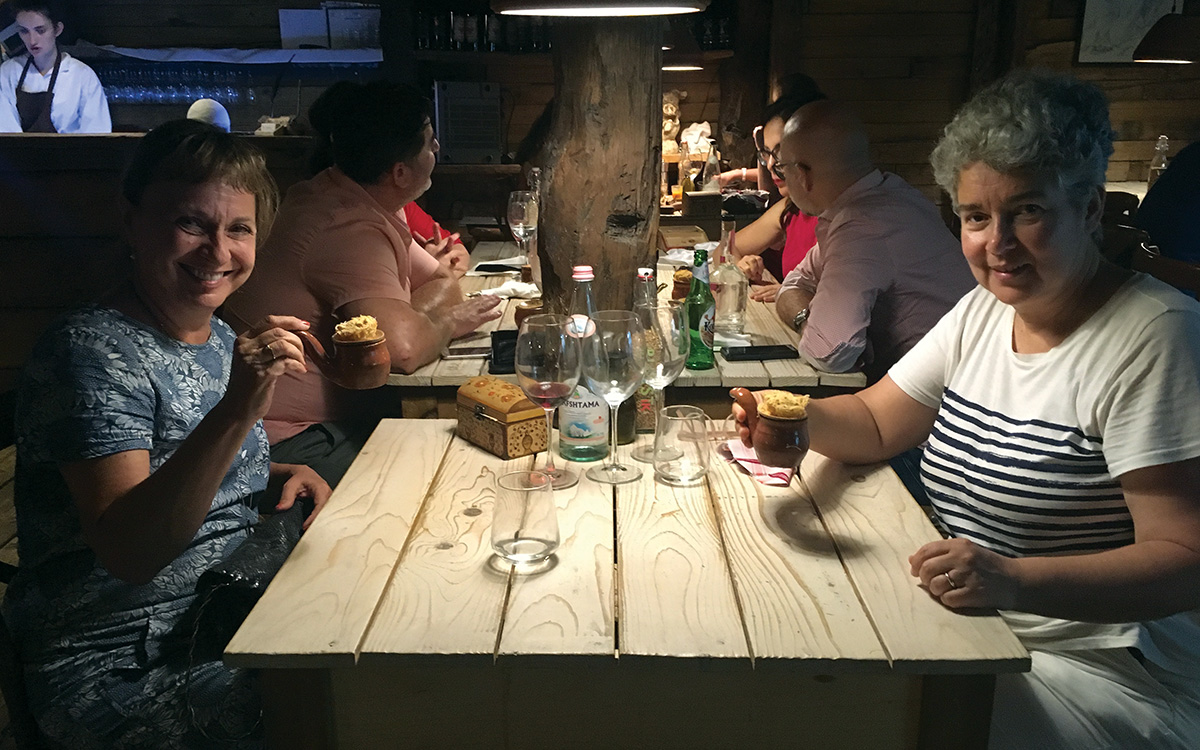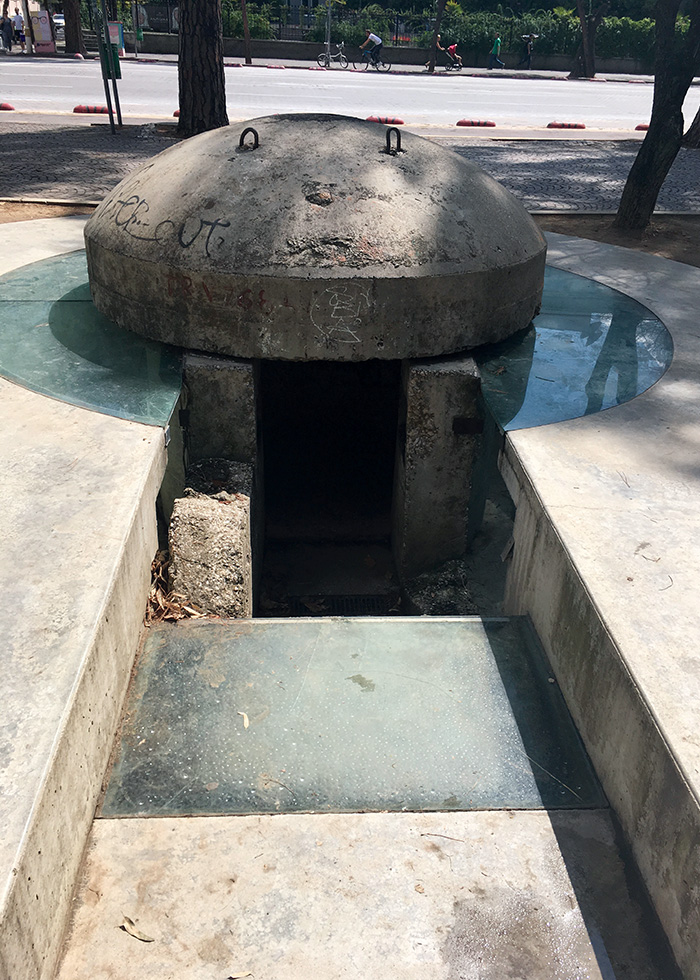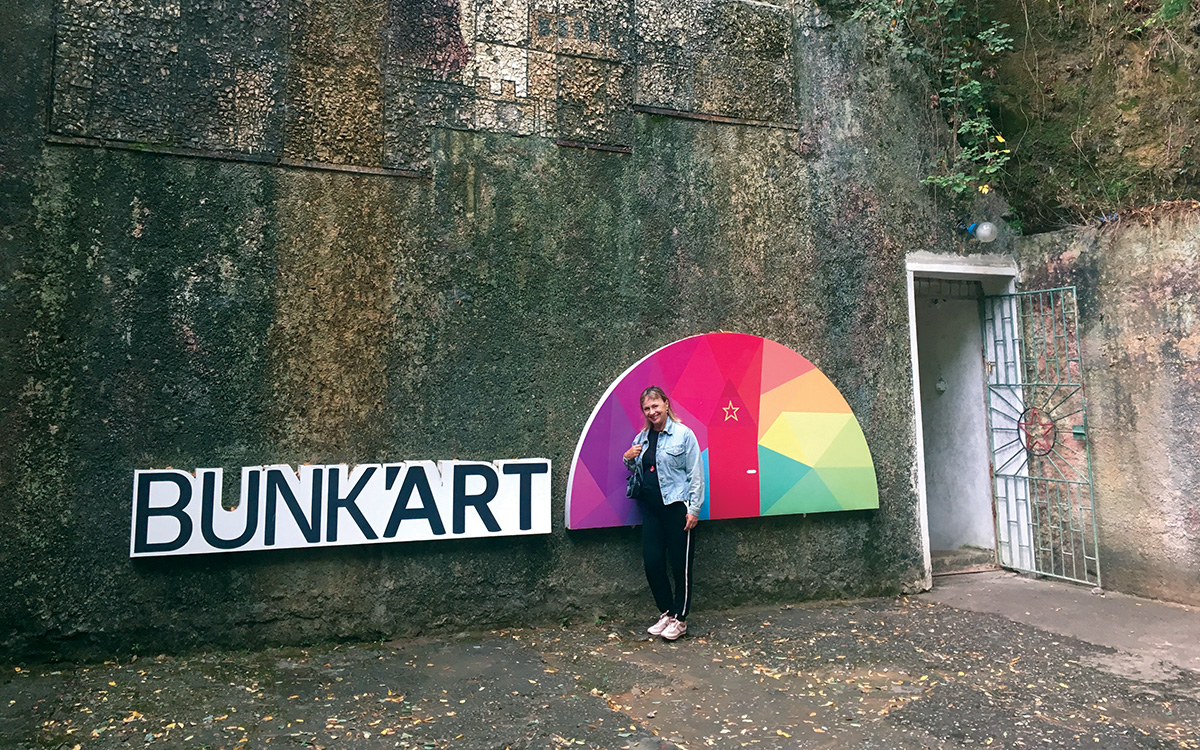An Unexpected Foray into Albania
Reflections
BY DOLORES BROWN AND MARIA SILVER

Maria Silver, at right, and Dolores Brown toast their renewed friendship at the Mullixhiu Restaurant.
Courtesy of Dolores Brown

A pillbox bunker in downtown Tirana.
Courtesy of Dolores Brown
Imagine walking the long tunnel to the tricked-out bunker of Albania’s former president, Enver Hoxha, who led—and isolated—his country from 1941 until his death in 1985. We contemplated all the human effort expended to satisfy Hoxha’s paranoia as he held his country in fear. It was unforgettable.
The “we” here are two retired Foreign Service officers who, true to our roots, remain intrepid. Together, we have more than 50 years of experience with the State Department. We bonded in the mid-1990s while working together on Belarus, another cloistered European dictatorship. Dolores was the analyst for Belarus in the Bureau of Intelligence and Research, while Maria was the desk officer.
Analyzing declarations by the wily Belarusian President Aleksandr Lukashenko, a former collective farm boss, we delighted in each other’s skepticism and wicked sense of humor. It helped that we were both alumnae of the same college (though we just missed each other at Barnard back in the 1970s) and aficionados of Eastern European history.
Twenty-plus years later, we reunited at Foreign Affairs Day 2019. Reminiscing, we wryly noted that the Belarusian dictator, still in power, had outlasted us on the job. It turned out that Maria, who has done nearly a dozen reemployed annuitant assignments since her 2011 retirement, was headed to Albania.
Dolores’ eyes widened. Long closed to tourists—much less U.S. diplomats—the country had transfixed her for years. She jumped at the opportunity to ask Maria if she’d like some company.
Soon we found ourselves on an unexpected foray into what was Europe’s fiercest communist state … and poised at the entrance to that long cold tunnel. Signs warned that it’s not for the claustrophobic.
We ventured through several sets of reinforced concrete doors two feet thick and explored tour highlights such as “decontamination” showers and weird audio recordings of Hoxha’s harangues and throngs singing the national anthem, replete with the line “with pickax and rifle.”
Hoxha’s five-story hideout, fitted with secret corridors and escape routes, was supposed to protect the ruler from nuclear, biological or chemical attack (which never came). In Albania, the people had bunkers, too. Both urban and rural landscapes are dotted with what look like giant beached sea turtles, testaments to Hoxha’s delusion that Albania would be punished for being Europe’s purest communist state.
He didn’t allow his population out or foreigners in. Adding to the absurdity, these bunkers wouldn’t have protected anyone from anything, except perhaps a stray tornado. Many are now used by Albanian teenagers for partying.
We shook our heads and agreed that we need to give the Albanian people credit for being uniquely long-suffering in a world that offers extensive competition.
We need to give the Albanian people credit for being uniquely long-suffering.
Located in the Balkans, Albania has been victim to centuries of power politics. Conquered by the Byzantines, Ottomans, Slavs, Serbs, Italians and others, it boasts a rich mix of Muslim, Greek Orthodox, Catholic and Sufi traditions (in the approximate order of prevalence) among its population of three million in a country the size of Maryland. Despite—or perhaps because of—its history, the country is internationally recognized for protecting Jews during the Holocaust.
Albania has probably the most kaleidoscopic mélange of religions, political systems and cultures that we had ever seen in such a small country, which makes it so utterly quirky.
An Albanian history professor who had lived through Hoxha’s reign shepherded us through Tirana, recounting personal experiences and historical insights.
He reminded us that Hoxha had been so upset at Khrushchev’s denunciation of Stalin that he broke off relations with the Soviet Union and informally allied with Maoist China shortly after. The professor described the obligatory Chinese clothing of that period, one of the most bizarre geopolitical vignettes we had ever heard.
We meandered to the Museum of Secret Surveillance, also known as the House of Leaves, which opened in 2017 in the building that served as the Albanian Secret Service’s headquarters during the communist era. Visitors can view the tools of oppression of a country that was struggling to feed its own people and had fewer than 3,000 cars at the time.
A foray into central Tirana revealed an enormous glass and marble pyramid built after Hoxha’s death to honor him and to house some of his possessions, pharaoh-like. Graffitied in a manner familiar to any New Yorker, it sits empty while authorities bicker over its fate. And just a few blocks away is one of Tirana’s main plazas, now named Mother Teresa Square.
We also journeyed to the town of Berat, an Ottoman-era architectural jewel on the UNESCO World Heritage list, overnighting in a centuries-old stone guesthouse found on Airbnb. We climbed to the Citadel, the fortress that dominates the town, and gazed across the valley at giant letters that had spelled “E-N-V-E-R,” Hoxha’s first name, before Albanians rearranged them to spell “N-E-V-E-R.”

Dolores in front of Hoxha’s bunker, a major Albanian tourist attraction.
Courtesy of Dolores Brown
We met many Albanians set on overcoming the past, such as Elton Caushi, the owner of Albania Trip, a company that is deftly promoting the country’s political patrimony and natural beauty. He recounted matter-of-factly how two young female Albanians desperately attempted to swim to Greek Corfu, covering their heads with hollowed-out watermelons to elude capture.
He and other creative entrepreneurs are at the heart of Albania’s integration into the West. Indeed, T: The New York Times Style Magazine named Tirana one of the 10 most enchanting places its writers visited in 2019.
And, indeed, Albanians are unabashedly pro-American and great admirers of American values, as the staff at Embassy Tirana helped us to understand. One of the embassy’s locally employed staff members said that the American landmark that most impressed him was Arlington National Cemetery—for its palpable display of respect for our fallen leaders and military members.
We capped our trip at Mullixhiu, a farm-to-table restaurant run by an Albanian chef who cut his teeth at the internationally renowned Danish restaurant Noma and returned home to establish a world-class restaurant in Tirana. We enjoyed an amazing dinner: jufka, homemade pasta with wild juniper berry; clay-baked quail; and a coffee dessert drunk from tiny pitcher spouts.
Albania is now in NATO and a candidate for accession to the European Union. As Albanians slowly recover from decades of isolation and repression, they are transforming one of Europe’s poorest countries into a democratic society—and fascinating tourist destination.
We are grateful to Albania. It brought us together again, reminding us of the fortitude of the human spirit and why we became diplomats in the first place.



